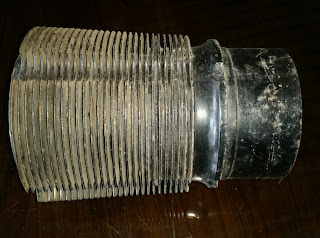Aircraft Engine
Classification -Aircraft engines can be classed by operating cycles, cylinder arrangement,
or the method of thrust production.
Heat engines - convert fuel into heat energy that is converted to mechanical energy to produce thrust. Most of the current aircraft engines
Internal combustion - the combustion process takes place inside the engine.
Reciprocating engines is classified by cylinder arrangement (in line,V-type, radial, and opposed) or according to the method of cooling (liquid cooled or air cooled).
Air-cooled engines- heat transfer is direct from the cylinders to the air by thin metal fins on the cylinders in order to have increased surface for sufficient heat transfer.
Inline Engine - one bank of even number of cylinders arranged inline has only one crank shaft, which is located either above or below the cylinders.If the engine is designed to operate with the cylinders below the crankshaft, it is called an inverted engine
The inline engine has a small frontal area and is better adapted to streamlining. When mounted with the cylinders in an inverted position, it offers the added advantages of a shorter landing gear and greater pilot visibility.
Opposed-type engine has two banks of cylinders directly opposite each other with a crankshaft in the center.
The opposed-type engine has a low weight-to-horsepower ratio, and its narrow silhouette makes it ideal for horizontal installation on the aircraft wings (twin engine applications). Another advantage is its low vibration characteristics.
V-type engines, the cylinders are arranged in two in‑line banks generally set 60° apart.
The radial engine consists of a row, or rows, of cylinders arranged radially about a central crankcase.
Radial engine consists of a row, or rows, of cylinders arranged radially about a central crankcase.
or the method of thrust production.
Heat engines - convert fuel into heat energy that is converted to mechanical energy to produce thrust. Most of the current aircraft engines
Internal combustion - the combustion process takes place inside the engine.
Reciprocating engines is classified by cylinder arrangement (in line,V-type, radial, and opposed) or according to the method of cooling (liquid cooled or air cooled).
Air-cooled engines- heat transfer is direct from the cylinders to the air by thin metal fins on the cylinders in order to have increased surface for sufficient heat transfer.
Inline Engine - one bank of even number of cylinders arranged inline has only one crank shaft, which is located either above or below the cylinders.If the engine is designed to operate with the cylinders below the crankshaft, it is called an inverted engine
The inline engine has a small frontal area and is better adapted to streamlining. When mounted with the cylinders in an inverted position, it offers the added advantages of a shorter landing gear and greater pilot visibility.
Opposed-type engine has two banks of cylinders directly opposite each other with a crankshaft in the center.
The opposed-type engine has a low weight-to-horsepower ratio, and its narrow silhouette makes it ideal for horizontal installation on the aircraft wings (twin engine applications). Another advantage is its low vibration characteristics.
V-type engines, the cylinders are arranged in two in‑line banks generally set 60° apart.
The radial engine consists of a row, or rows, of cylinders arranged radially about a central crankcase.
Radial engine consists of a row, or rows, of cylinders arranged radially about a central crankcase.




Comments
Post a Comment